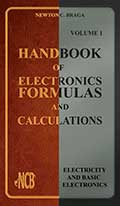 Author: Newton C. Braga
Author: Newton C. Braga
Published: Aug, 2016
Formato: Book and e-Book
Pages: 226
Some years ago I had written a book directed to anyone who designs electronic and electric circuits. Engineers, technicians, teachers, students and hobbyists took a real benefit from that book. The original book is now out of print, being available only used issues. Since the book is very useful, the author decided to review the old edition, add new content and so create a new book for anyone who need a fast access to formulas, tables and calculations when designing his projects or solving a problem.
The author, who has himself designed multitudes of projects and circuits during his life, publishing many books and hundreds of articles in electronics magazines and teaching electronics, has collected an assortment of all basic information necessary for calculations needed when designing new projects or solving a problem.
More part of these formulas and calculations is now in the author´s site at www.newtoncbraga.com. The site also has versions in Portuguese (www.newtoncbraga.com.br) and in Spanish (www.incb.com.mx).
In the site the reader will also find practical examples in projects or articles where many of the formulas shown in this book are used.
When starting a project or solving a problem the main difficulty the designer or student founds is how to locate the desired information. This information is normally spread over a large number of resources, such as books, handbooks, Internet, and magazine articles.
Although many of us who are experienced in electronics have in mind the principal formulas, we sometimes have trouble with the forgotten constant, multiplication factor or exponent. Finding these values is sometimes difficult depending of the circumstances, such as where you are at the time, or the amount of resources at your disposal.
Part 1 - DC Formulas
1. Units
2. Resistance of a conductor
3. Conductance
4. Conductance of a Length of Wire
5. Thermal Influence in the Resistance of a Cable
6. Ohm´s Law
7. Electric Power
8. Joule´s Law
9. Electric Energy
10. Electrolysis (Faraday´s Law)
11. Resistors in Series
12. Resistors in Parallel
13. Voltage Divider (resistive)
14. Loaded Voltage Divider (resistive)
15. First Kirchhoff´s Law
16. Second Kirchhoff´s Law
17. Capacitance
18. Planar Capacitor
19. Breakdown Voltage in a Capacitor
20. Energy Stored in a Capacitor
21. Capacitors in Parallel
22. Capacitors in Series
23. Magnetic Field of a Solenoid
24. Magnetic Induction inside a Solenoid
25. Inductance
26. Inductances in series
27. Inductances in Parallel
28. Mutual Inductance
Part 2 - AC Formulas
-----
29. Frequency and Period
30. Cyclic or Angular Frequency
31. Average Value
32. RMS Value
33. Frequency & Wavelength
34. Capacitive Reatance
35. Inductive Reactance
36. Quality Factor (Factor-Q)
37. Ohm´s Law for AC Circuits
38. RL in Series
39. RC in Series
40. LC in Series
41. RLC in Series
42. RC in Parallel
43. LR in Parallel
44. LC in Parallel
45. Ressonance
46. Time Constant (RC Circuit)
47. Time Constant (LC)
48. Inductive Coupling Using Transformers
49. Direct Inductive Coupling
50. Ohmic Coupling
51. Capacitive Coupling
52. Low- Pass Filters
53. High Pass Filters
54. Band-Pass Filters
55. Differentiation
56. Integration
57. Noise
58. Bandwidth
59. Voltage Ratio in Transformers
60. Current Ratio in Transformers
61. Impedance Ratio in Transformers
62. Decibel
63. The Neper
64. Balanced T-Attenuator
65. Balanced π-Attenuator
66. Unbalanced T-Attenuator
67. Unbalanced π-Attenuator
68. Half-Wave Dipole
69. Folded Half-Wave Dipole
70. Range (VHF and upper signals)
71. Coaxial Cable
72. Two-Wire Balanced Line
73. Impedance Match or π-Network
----
Part 3 - Electronic Circuits
74. Semiconductor Diode
75. Half-Wave Rectifier
76. Full-Wave Rectifier
77. LC Filter Coefficient
78. RC Filter Coefficient
79. Ripple Factor
80. Filter Inductance
81. Filter Capacitance
82. Conventional Voltage Doubler
83. Cascade Voltage Doubler
84. Bridge Voltage Doubler
85. Full Wave Tripler
86. Cascade Voltage Tripler
87. Full-Wave Voltage Quadrupler
88. Zener Diode
89. Capacitive Voltage Divider
90. NTC
91. PTC
92. VARICAPS
----
Part 4 - TRANSISTORS
93. Transistor Static Current-Gain (Common Emitter)
94. Transistor Static Current Gain (Common Base Configuration)
95. Relationship between Alpha and Beta
96. Hybrid Parameters
97. Common Base
98. Common Emitter
99. Common Collector
----
Part 5 - Basic Quantities of Circuits Using Transistores
100. Short-Circuit Output
101. Open Circuit Output
102. Short-Circuit Input
103. Open-Circuit Input
104. Common-Base Configuration Usual Formulas
105. Common-Emitter Configurations Usual Formulas
106. Common Collector Usual Formulas
-----
Part 6 - TRANSISTOR PRACTICAL FORMULAS
107. LOAD RESISTANCE
108. Base- Biasing Resistance
109. Automatic-Biasing Resistance
----
Part 7 - JUNCTION FIELD EFFECT TRANSISTOR-JFET AND THE MOS FIELD EFFECT TRANSISTOR (MOSFET)
110. Common Source
111 – Common Drain
112. Common Gate
113. UJT – Unujunction Transistor
114. SCR
115. TRIAC
----
Part 8 - OSCILLATORS
116. Astable Multivibrator
117. Neon-Lamp Oscillator
118. Phase Shift Oscillator
119. Wien Bridge Oscillator
120. Twin-T Oscillator
121. Hartley Oscillator
122. Colpitts Oscillator
123. CMOS Two-Gate Oscillator (I)
124. CMOS Two-Gate Oscillator (II)
125. CMOS Schmitt Tri
... and More




